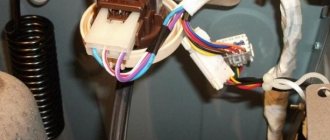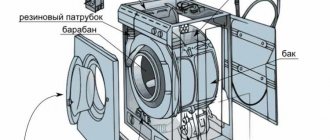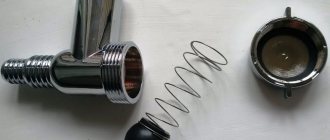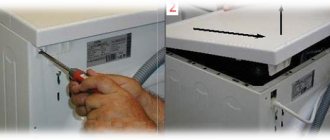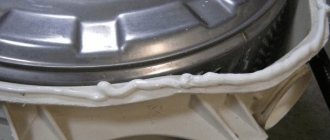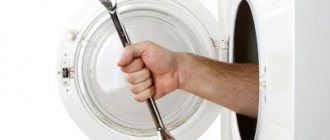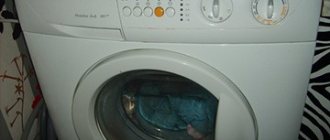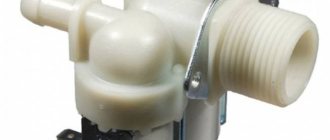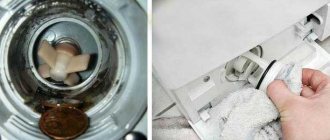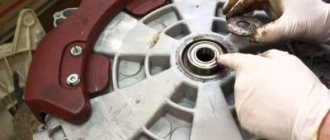Washing machine pump - purpose
The function of the washing machine pump (pump) is to pump water into the unit’s tank at the beginning of the wash and remove the waste liquid at the end of the process. The pump itself consists of an impeller (a wheel-shaped element with blades), an electric motor and a volute.
A hose is connected to the device, through which the liquid is drained, as well as a pipe. The pump has a fairly simple structure, but its incorrect operation causes a number of malfunctions in the operation of household appliances.
Main causes and symptoms of malfunction
Before we get started with repairs, let's find out how the pump works and why it might break.
After finishing washing, before rinsing, the machine must be drained of waste water. The control module sends a signal to the pump, which starts and pumps water into the drain pipe. From there the water goes into the sewer.
How to understand that the pump is faulty
If your SMA has a self-diagnosis system, it will display an error code on the display.
Errors may differ for different brands:
- Samsung (Samsung) is the code E2 and . They mean problems with water drainage, as well as an increased water level in the tank. The values indicate the pump that needs to be tested.
- LG machines show the same error as .
- Indesit and Ariston washing machines will display codes F05 for problems with the drain and F11 for problems with the pump.
- SM brands Electrolux and Zanussi display code E21 on the display, which means: no water drainage.
- The same problems appear in Atlant models like, in Gorenje - F5, and in Hansa cars E03 is displayed.
In order to correctly decipher the code, look at the fault table of your brand. We wrote about them in previous articles.
Externally, the user may notice the following problems:
- No water drainage.
- The machine has stopped in the middle of a wash cycle. The water does not drain.
- During draining, the SM makes a lot of noise and buzzes.
Causes of problems
Here are the main reasons:
- Clogged drain system: filter, pipe, pump.
- Clogged sewer system.
- Defects in electrical contacts and connections.
Before replacing the pump in the washing machine, you need to rule out other faults.
Drain filter
A clogged filter can cause problems with the pump. Therefore, turn off the water and find a small hatch at the bottom of the front panel. Open it with a screwdriver and place a container to collect water. Unscrew the filter clockwise and inspect it for blockages. Clean the part.
To check the pump impeller without disassembling, look into the filter hole with a flashlight. If the impeller rotates, it means the pump is functioning. If not, there is probably a blockage or a problem.
By turning on the washing machine, you can check its operation. Isn't it a blockage? Let's move on.
To check the pipe and the pump itself, you need to get to the location of the pump. It differs in different models.
How to understand that the pump is faulty
If there is no pumping or removal of water at the appropriate stage of washing, the question arises of how to check the pump in the washing machine.
Signs of a part failure are:
- increased noise level when draining or filling water;
- shortage of pumped water volume;
- very slow drain;
- inability to turn on the spin mode;
- interference or equipment shutdown during liquid collection;
- lack of response to manual programming.
If the above-mentioned alarming signs are detected, diagnostics must be carried out, the pump must be cleared of the blockage, and, if necessary, repair work or replacement of parts must be carried out.
Where is the pump located in the washing machine?
Depending on the model of household appliances, the following pump location options are possible:
- At the bottom. The most popular option is to access the pump through the bottom. To do this, place the unit on its side and remove the bottom cover. After completing these manipulations, you will be able to see the detail.
- Behind. By placing the pump at the back of the appliance, access to it is simplified. The machine is moved away from the wall and the back panel is removed (usually it is attached to the body with bolts). The pump will be visible at the bottom.
- Front. The most difficult case is when the front panel must be removed to access the pump. This design is typical for machines of the Siemens and Bosch brands.
How to remove a washing machine pump
To choose the optimal algorithm for removing the pump from a washing machine, you need to know the location of access to the pump for a given model of washing machine.
Depending on it, you can use one of the options:
- If the pump is reached through the bottom, you need to remove the bottom cover, unscrew the side screw, place a basin or pan for the liquid and start unscrewing the filter. At this time, water will flow into the container. The pump is moved counterclockwise and brought out through the bottom of the household appliance. Separate the clamps and wires.
- When removing the rear panel in a vertical position, disconnect the drain hose, remove the nails securing the panel and remove it. Disconnect the terminals and wires. Unscrew the pump and separate the pipes.
- When working with the front panel, remove the powder container from the machine and unscrew the bolt located under it. The lower door of the filter is opened, the bolt is unscrewed and the lower cover is removed. The remaining two bolts, the rubberized hatch gasket and the hatch lock are removed. Now the front panel is completely retracted. After unscrewing the bolt, place the dishes to drain the liquid. Remove the clamp with the pipe and drain the waste liquid.
Causes of failure
Below are the main causes of the malfunction, as well as how to fix them yourself.
Blockage
A clog is indicated by an unusual humming sound when the machine cannot drain the water. The causes may be objects that have gotten inside the pump or hose, into a pipe, sewer, or during the water supply.
There are two types of blockages. Mechanical occurs when foreign objects get into the hose: buttons, coins, etc. They block the passage of water into the system. Natural clogging is when hair, lint and other small debris get into the filter.
The first type of blockage is easy to prevent. Before washing, it is necessary to carefully check all pockets, fasten all buttons and use special mesh bags for clothes. The second type occurs over time and is difficult to prevent completely, so once a month or less, depending on the frequency of use of the machine, it is necessary to clean the hose and filter.
A filter for mechanical water purification will prevent clogging of the supply hose; the main thing is to change it periodically, depending on the type of filter used.
Part wear
The wear of the pump is caused by foreign objects and debris getting into it, and the machine begins to make a lot of noise. The average pump life is 10-12 years. Operating time may vary and depends on frequency of use.
Hard and dirty water leads to scale formation and reduces the life of the pump. It is recommended to use water softener with each wash cycle.
Practical recommendations for preventing wear on the washing machine pump:
- Thoroughly clean clothes from pieces of dirt
- Check pockets before washing
- Install an inlet filter
- Use water softeners when washing
Before washing pet bedding, they should be thoroughly cleaned of hair (this is especially true for owners of long-haired dogs and cats). It is wool and hair that become one of the reasons for rapid wear of the pump.
- After the end of the wash cycle, drain the water from the tank completely
- Clean the external filter periodically
- Compliance with the recommendations increases the service life of the pump by at least 4-5 years.
DIY drain pump repair
Repairs are carried out in parallel with checking the functioning of the main parts.
Sequencing:
- Determine whether there is excessive noise when the pump is operating.
- Find out if the filter and drain hose are clogged. The first one can be easily cleaned by hand if necessary. To clean the hose, remove it and place it under water so that the stream passes through it.
- Run the machine in rinse mode to check the operation of the pump. It is considered to be in good condition if water flows inside the tank at the required speed and an increased noise level is not generated during operation of the washing machine. If failures occur, proceed to the next step.
- Check that the impeller rotates correctly. To access it, you need to unscrew and remove the filter. The blades are rotated by hand to see how smoothly they rotate. If foreign objects or contamination are found, they must be removed.
If the problem is not solved after taking the above measures, the washing machine is taken to a service center or to a private technician - most likely, the electronics of the unit have failed.
Do-it-yourself pump repair
If the drain pump in the washing machine fails due to burnout of the electrical winding, then in this case it is necessary to replace the part. In other cases, it is often possible to restore the device to full functionality, for which you should first clean the impeller and filter. To clean the impeller, you will need to disassemble the device housing.
Disassembling the drainage device
The cause of deterioration in the performance of the drain mechanism, as well as complete jamming of the working shaft, may be threads, hair or long wool. It is necessary to carefully inspect the impeller and shaft and, if such contamination is detected, clean them using a thin screwdriver. The inside of the cochlea also needs to be wiped to remove soap deposits on its walls.
When the parts are cleaned, wash the two halves in water without immersing the engine. Then you need to assemble the housing, connect the pipes and electrical terminals to it and install it in its original place.
When the process of installing the cleaned pump is completed, turn the machine into rinsing mode and check the operation of the drain mechanism. If the device operates in normal mode, then no more
no measures are required; if it was not possible to repair the pump in this way, then it is necessary to replace the electric drain pump in the washing machine.
If the pump has served for more than 5 years, and diagnostics show the need to replace it, you will need to purchase a new one. To increase the service life of your pump, you need to choose it correctly.
When choosing a pump, consider the following parameters:
- Fastening to the volute: with 3 screws or 3, 4 and 8 latches. The mountings of the new pump should be the same as the old one. Otherwise, it simply won't fit.
- Method of connecting wires: “chip” and “terminals”. If, instead of a pump with a chip, you purchase a model with terminals in the form of terminals, you will need to trim the double wires at the end, strip and install the terminals.
- Placing a contact group. Can be located behind or in front. The location doesn't matter much. This does not affect the operation of the pump.
- Manufacturer of drain pumps. There are several universal brands: Coprecci, Arylux, Mainox, Hanning, Plaset, Askoll. Pumps from these manufacturers are interchangeable.
- Pump power indicated on the sticker. This parameter is not very important, since it is approximately the same for all models.
It is difficult for an ordinary person to understand the design features of pumps, so when choosing a new device, it is better to consult a professional.
The design diversity of drain pumps is, first of all, determined by the features of the plastic pipe (volute) and the debris filters combined with them.
In modern models, manufacturers use three types of pumps:
- on three volute screws (Samsung, Indesit, Ardo);
- on three volute latches (AEG, Bosch);
- on eight snail latches (LG, Zanussi).
Pumps of the same type are interchangeable. For example, a Samsung pump is suitable for an Indesit brand car and vice versa.
If after checking and cleaning the impeller the problem is not resolved, then it is more serious and you will need to disassemble the pump and carry out a more detailed inspection.
Under heavy loads, the pump is protected by fuses that are located on the winding of the part and are switched off. When the temperature normalizes, the contacts are restored.
First you need to disconnect the pump from the cochlea. In general, there are two types of fastening: simply with screws and without screws (you only need to turn the pump counterclockwise). At this stage, you can find out whether the impeller rotates on the shaft. Normally, it should spin with small delays, so-called jumps.
The motor housing has a latch on both sides that needs to be unhooked with a screwdriver. This is if your car has a collapsible motor, but there are non-separable types. At first glance it is impossible to make out, but if you know some of the nuances, you can.
We suggest you familiarize yourself with which brand of washing machine is better: how to choose a good washing machine
A construction hair dryer will help by heating the long part of the part, the so-called shank, at a low temperature. After heating the shank, the crosspiece with the magnet is removed from the housing. Usually dirt accumulates on the magnet and in the place where it was pulled out. After cleaning, the magnet itself is removed. Next you will see the bearing, which is also cleaned and lubricated.
Bearing wear
If runout appears during shaft operation, it means the bearings are faulty.
Because of this, friction appears between the volute and the impeller, which causes problems and repairs of washing equipment pumps. The problem can be solved by replacing the bearings. In an emergency, when it is not possible to buy a new part, and washing cannot wait, only shortening the blade by no more than 2 mm will save you. This is done with a sharp knife.
After repair, the housing is installed in the coil and fixed. This concludes troubleshooting the pump on your own.
Replacing the drain pump in a washing machine
If the pump breaks down, you need to replace it. It is important to choose a part that is suitable for a specific model of the unit - for this, before purchasing a pump, you should consult the seller.
Work to replace the drain pump of a washing machine is carried out as follows:
- Unplug the washing machine from the outlet and block access to water.
- Gain access to the part in accordance with the design of the unit.
- Unscrew the pump, having first unscrewed the screws holding it.
- Separate the wires going to it.
- Remove the hose and pipe and drain the water.
- Installing a new pump.

